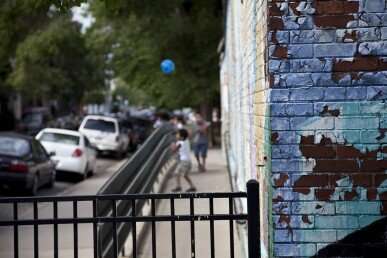Chicago neighborhoods with barriers to social distancing had higher COVID-19 death rates

New research has found that Chicago neighborhoods with barriers to social distancing, including limited access to broadband internet and low rates of health insurance, had more COVID-19 deaths in spring 2020. The study, led by researchers at the University of Illinois Chicago, is published in the Annals of Epidemiology.
"We wanted to look at neighborhood characteristics that may contribute to higher death rates in certain neighborhoods in Chicago," said Molly Scannell Bryan, a research assistant professor at the UIC Institute for Minority Health Research and corresponding author on the paper. "We originally expected that air quality and use of public transportation would be drivers, but we found that heightened barriers to being able to social distance, such as low or lack of internet access, was a more significant driver of COVID-19-related deaths, possibly through a higher risk of infection in those without internet access."
COVID-19 is the illness caused by the SARS-CoV-2 virus, which emerged in fall 2019 and declared a pandemic by the World Health Organization in March 2020. In the United States, over 270,000 Americans have died of the disease.
The researchers sought to identify patterns in the census tracts with high rates of COVID-19 mortality in Chicago during the spring and early summer of 2020.
They looked at 33 neighborhood characteristics for each census-tract. Chicago has almost 1,000 census tracts, each with approximately 4,000 people.
Neighborhood descriptors were obtained from the U.S. Census Bureau's American Community Survey and information on COVID-19 deaths was obtained from the Office of the Medical Examiner of Cook County. Highly localized estimates of air quality, including nitrogen dioxide, ozone and very fine particulate matter, were obtained from colleagues at Northwestern University.
Between March 16 and July 22, 2,514 COVID-19 deaths were recorded in Chicago.
The data revealed that COVID-19 death rates in Chicago showed similar racial disparities to those seen nationwide. Although non-Hispanic Black residents comprise 31% of Chicago's population, they accounted for 42% of the COVID-19 deaths. Deaths among Hispanic/Latino residents occurred at a younger age—63 years, compared with 71 for white residents.
After focusing on deaths that occurred outside of nursing homes, the researchers found that higher COVID-19 mortality was seen in neighborhoods with heightened barriers to social distancing and low health insurance coverage. Neighborhoods with a higher percentage of white and Asian residents had lower COVID-19 mortality. Mortality among white residents was highest in neighborhoods with lower educational attainment and a higher percentage of Hispanic/Latino residents. Among whites, mortality was lower in neighborhoods with a higher percentage of white or Asian residents.
"Barriers to social distancing really jumped out as a major driver of mortality, likely through increased risk of infection," Scannell Bryan said. "Neighborhoods where residents do not have internet at home means residents are more likely to need to leave the house more often and come into contact with more people outside the home. In the spring, when there were such high levels of community spread, this would have put those people at higher risk."
The researchers also found that while the overall death rate was higher among Black residents, no neighborhood characteristics were associated with COVID-19 death rates among Black residents specifically. In contrast, among white residents, neighborhood characteristics seemed to matter.
"We saw that white residents who died clustered in neighborhoods with higher levels of social vulnerability, whereas Black and Hispanic/Latino residents who died lived in neighborhoods with both high and low levels of social vulnerability.
"Our study revealed several neighborhood characteristics that are linked to higher COVID-19 death rates and these are the places that might benefit from additional testing and resources to connect residents to health care," Scannell Bryan said.
More information: Molly Scannell Bryan et al, COVID-19 mortality and neighborhood characteristics in Chicago, Annals of Epidemiology (2020). DOI: 10.1016/j.annepidem.2020.10.011





















